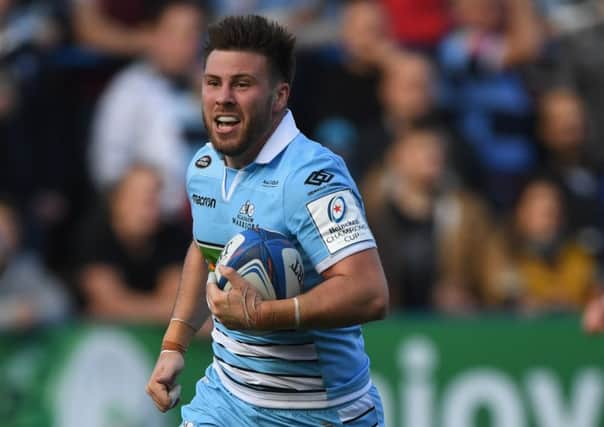Allan Massie: Sporting all-rounders a vanishing breed


Glasgow, after scoring a truly beautiful try in almost the first play of the game, proceeded to make so many mistakes that they condemned themselves to a heavy defeat. If you put restarts straight into touch, miss touch from a penalty, kick full into touch after taking the ball back into the 22, and repeatedly fail to deal with opposition box-kicks, you are setting yourself up to lose against pretty well anybody, let alone a team of Saracens’ quality. Well, both have a chance – some might say, the duty – to redeem themselves this week. Glasgow will, of course, have played Ulster by the time you read this, and done so knowing that victory would take them a step further towards a home semi-final. Edinburgh have a stiff task away to Scarlets, aware, too, that defeat might have them teetering on the edge of failing to qualify for the Champions Cup next season. This would be a bitter thought, knowing,as they must, that a week ago they should have secured their place in this year’s semi-final.
Still not all was doom and gloom on Saturday. Down at Philiphaugh, Selkirk held on by the proverbial skin of their teeth to beat Gala 19-18 and so secure their place in next season’s new top division of the amateur game. All Selkirk’s points – a try, conversion and four penalties – were scored by fly-half Rory Banks.
Advertisement
Hide AdAdvertisement
Hide AdHe belongs to a vanishing breed, the all-round sportsman, for he has also captained Selkirk Cricket Club, being an attractive attacking batsman and a more than useful bowler. This crossover from the winter to the summer game used of course to be common. Twenty years ago in the Borders there were men like Adam Roxburgh, Rob Moffat and Neil Crooks (affectionately known as that “bald-heided Gala bastard”) who had their whites on as soon as the Spring Sevens were concluded. It’s partly the extension of the winter games’ season and partly the ever-greater demands on players’ time and commitment that makes this unusual now. The Glasgow Warriors website will inform you that Scotland scrum-half Ali Price played youth-grade cricket for Cambridgeshire, but I doubt if he has had much opportunity to pick up a cricket bat since he enrolled at Scotstoun.
Around the turn of the century Norman Mair, who for so long graced these pages and who himself played both rugby and cricket for Scotland (as did the nonpareil of full-backs, Ken Scotland), used to tell me it was “such a pity Duncan Hodge no longer plays cricket – he was such a good batsman at Merchiston”. Likewise a Wisden of the late Nineties – 1998 or 99 – will tell you that a certain M L R Blair headed the bowling averages for The Edinburgh Academy. I doubt if M L R Blair, better known as Mike, former Scotland scrum-half, now Scotland assistant coach, has done much bowling since.
On the other hand Stuart Moffat, three or so years ahead of Blair at the Academy, got four Scottish rugby caps and, rather remarkably, hit a hundred for Cambridge against Oxford. Since this was his only innings in first-class cricket he finished his career with a first-class average of 169, considerably higher than Don Bradman’s.
Nobody in these days of specialisation would look for an all-rounder like Scotland’s Edwardian hero K G Macleod who played rugby for Scotland, cricket for Cambridge University and Lancashire, football for Manchester City, and then, in middle age, was amateur golf champion of Natal. Mention of Natal calls Roy McLean to mind. He was a brilliant attacking batsman for South Africa though a wretched starter, his five Test centuries being bracketed, as it were, by 11 Test ducks, but he was also a very good fly-half who dropped a goal to enable Natal to beat the touring Wallabies.
South Africa indeed produced a good many dual internationalists. Clive van Ryneveld, a good batsman and useful leg-spinner, captained the Springboks on their 1955 tour of England, but a few years previously, while a Rhodes Scholar at Oxford, he had played rugby for England as a centre three-quarter.
Those who moan and agitate on have-your-say websites about qualifications to play international rugby today may be surprised to learn that we were all much more relaxed about it in the old amateur days. English rugby selectors kept an eye on Rhodes Scholars and Martin Donnelly, the great New Zealand left-handed bat, was capped at fly-half for England in 1947. Two years later he made 206 for New Zealand in the Lord’s Test.
The SRU have rarely been slow in happening on anyone with some sort of Scottish qualifications. In the dark years 1951-55 when we lost 18 internationals in succession, they gave a few caps in the centre to Kim Elgie, a South African student at St Andrews. Having graduated, he returned home and was capped for South Africa at cricket with, sadly, little, if any, more success than he had enjoyed playing rugby for Scotland.